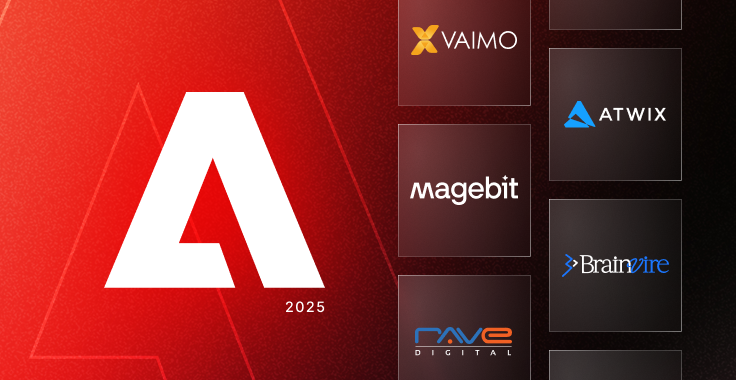The ABCs of AR/VR
The swift progress of Augmented Reality (AR) and Virtual Reality (VR) technologies has had a profound impact on a multitude of industries, with eCommerce standing out as a prime example. As a result, the traditional boundaries between digital and brick-and-mortar shopping are beginning to blur, paving the way for a more dynamic and interactive eCommerce landscape.
The integration of AR and VR enables retailers to elevate the customer experience, offering a new level of personalization and convenience that is reshaping the entire industry.
AR/VR: key data and insights
Augmented reality (AR) and virtual reality (VR) are becoming increasingly popular trends in digital commerce with each passing year. Here are some statistics that highlight the growing role of AR/VR in eCommerce:
- According to Shopify stats, AR users experience a 94% higher conversion rate than users who don't utilize the tool.
- The same stats also revealed that 40% of shoppers are willing to pay more for a product if they can preview it using AR.
- In 2020, the global AR and VR retail market size was valued at USD 2.7 billion and is projected to reach USD 11.6 billion by 2027.
- Furniture retailer IKEA reported a 200% increase in conversions since the launch of their AR app.
Effects on eCommerce
As technology continues to advance and become more accessible, it's safe to expect that more retailers and digital companies will integrate AR/VR into their eCommerce platforms.
Moreover, these technologies enable businesses to stand out from the competition, attract more customers, and drive brand loyalty.
To sell a product, you must create an emotional connection with the customer. Using AR/VR you offer a unique, interactive experience that sparks curiosity and bridges the gap between online and in-person shopping. These technologies provide detailed visuals, virtual store exploration, and a sense of personalization.
Leveraging the benefits
- What's better than visualizing a picture in your head? That's right – seeing it on a screen. With AR and VR, buyers can view products in greater detail and context, enabling them to make more informed decisions. By offering realistic visualizations in simulations, AR/VR-powered features reduce uncertainty and allow buyers to objectively weigh the pros and cons.
- Frustrating return experiences are a hassle for both buyers and suppliers. By bringing a new level of convenience to online shopping and providing customers with a more accurate view of products through AR and VR, companies significantly decrease the likelihood of returns due to dissatisfaction or unmet expectations. This not only saves companies time and resources but also creates a positive experience for the customer.
- Every company is trying to stand out from the crowd with its own appeal, and implementing AR and VR technologies can prove to do just that. Implementing these technologies definitely positions your brand as an industry leader and a company that keeps up with the times, attracting customers who appreciate innovation and strive for the latest trends.
AR/VR in eCommerce: real-world company examples
Porsche
The luxury car manufacturer has developed the Porsche AR Visualizer app, which allows users to customize their dream car and visualize it in 3D from any device. With this solution, potential customers can explore different car models, colors, interiors, rims and so on. In this way, an engaging and personalized experience is created. By offering this personalization tool, Porsche can better respond to individual preferences and encourage potential customers to take the next step in the buying process.

Bauer
The leading supplier of ice hockey equipment has been using its own VR scanner for several years to offer a virtual skate fitting service called Bauer 3D Skate Lab. The scanner's operating principle allows customers to find the perfect skate fit by simulating the process of a physical fitting. By analyzing the customer's foot shape, size and preferences, the system recommends the optimal skate model and size for the ideal result. This personalized approach enables customers to make more informed purchasing decisions, reduces the likelihood of returns due to the wrong size, and maximizes the likelihood of making the right choice.

Sephora
The global beauty retailer has introduced Sephora Virtual Artist, an augmented reality (AR) tool that allows customers to interactively try on various makeup products. Users can experiment with different shades and styles to confidently find the perfect combination for their skin tone and preferences. This innovative AR feature assists customers in making informed purchasing decisions, ultimately leading to higher conversion rates and fewer returns.

How to successfully implement AR/VR into your online store
Integrating AR/VR into your eCommerce strategy offers numerous benefits that can help your business thrive in an increasingly competitive environment. By utilizing these tools, you create an engaging, personalized, and immersive shopping experience that sets your business apart from competitors.
- As statistics demonstrate, AR and VR technology captures the attention of potential customers and engages them, ultimately leading to increased customer acquisition and retention.
- By providing your customers with a memorable and personalized shopping experience using AR/VR, you can establish a closer connection with your audience.
- AR and VR can be employed to enhance customer support by offering virtual product demonstrations, troubleshooting assistance, or interactive tutorials. This helps customers better understand your products or services and resolve potential issues more effectively.
- These technologies can also be used to gather customer feedback and obtain valuable information on product performance, design, and user experience. Received data can be leveraged to refine your products or services so that they align with customer needs and preferences.
- Adopting AR/VR will help your business access new markets and segments, as customers are increasingly drawn to innovative and engaging experiences.
Remember the success formula: To grow a business, stay ahead of trends with innovative ideas.
Wrapping up
In summary, AR and VR aren't far behind and their impact on eСommerce is already undeniable as a growing number of companies have recognized their potential to revolutionize shopping behavior. Companies such as Porsche, Bauer Hockey, Sephora and IKEA have already led by example, demonstrating that adopting this tool has only benefited them and ultimately contribute to their growth and revenue.
By leveraging AR/VR, you're plunging into a new future and creating an engaging, personalized and immersive customer experience that will set your business apart from the competition and increase the loyalty of your customer base.
















